Route: X18, Berwick-upon-Tweed to Newcastle-upon-Tyne
Operator: Arriva
Timetable: Every 2 hours (Mon-Sat); 2 per day (Sun)
Time: ~4 hours
Cost: £8.50 Day Ticket
Date of Trip: 1/5/19
Alnwick on the Streets of London: Ian & Eleanor
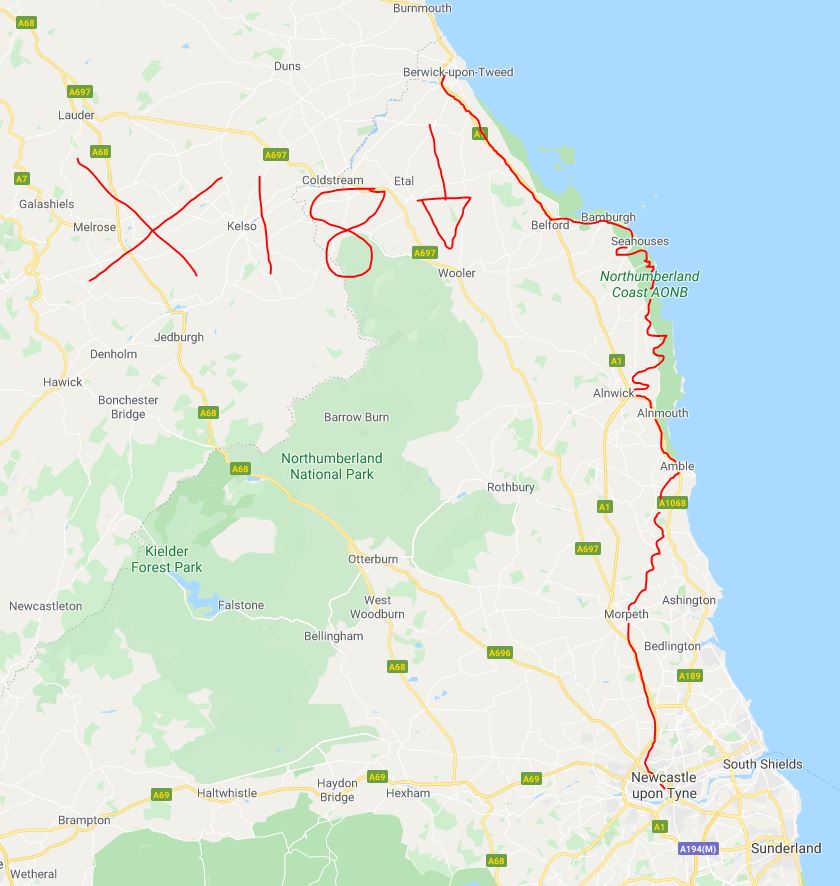
A squadron of shrieking seagulls performs a flypast on Castlegate, the upper portion of Berwick’s chief shopping street. A rapid strafe of splats follows, raining onto the floor right beside us. Guano pools on the town’s pavements, while strewn across each wall is so much pooey residue that we could be in a town-wide Jackson Pollock installation. The birds here must live on prune juice, baked beans and castor oil.
Despite this unusual decoration, Berwick is the friendliest place I’ve ever visited. We make 20 new acquaintances in as many minutes, with unsolicited hello’s swapped with unfamiliar faces as we tour the narrow side streets down to the River Tweed and back up to our bus stop on Golden Square – a regular street which is neither golden nor a square.
‘Hiya, can we have a family day ticket, please?’ I ask the driver of the X18 with our £13.50 fare at the ready.
‘No,’ he replies. He’s from down south.
‘Oh, right. Why?’
‘Well, you’re a couple, not a family.’
‘But we’re married. It’s our anniversary.’ Fifteen years and counting as of today.
‘Yeah, but you don’t have any kids with you, so I’ll have to do you individual day tickets instead. £8.50 each, please.’
Bus tickets can be infuriating, especially when they’re left open to interpretation, or an edict from one garage contradicts accepted practice elsewhere on the same network. In this instance, to quote from Arriva’s website, ‘Family tickets are valid for parties of up to 2 adults and up to 3 children travelling together, with at least 1 adult and 1 child travelling as a minimum.’
It’s easy to see where the confusion sets in, but it doesn’t mention that you must have an under-16 with you, never mind the anti-logic that it’d cost us £4 less travelling with three snappers in tow than it would without them.
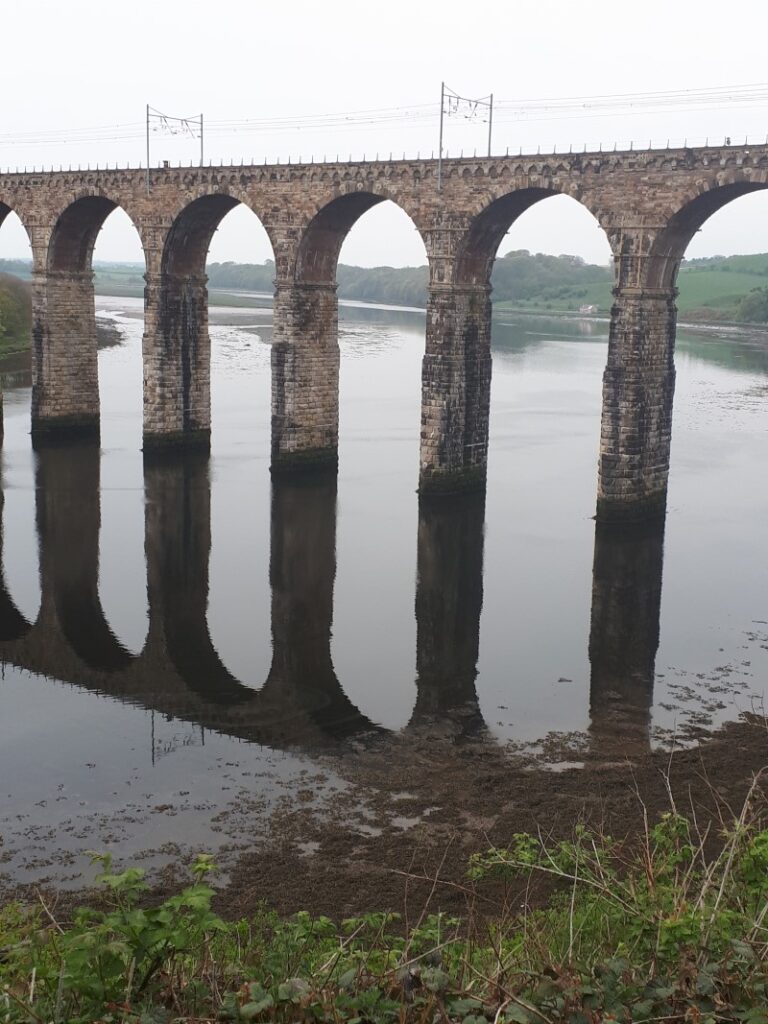
Regardless, we hand over the reddies and take our seats on the top deck, where the only other passenger is an Australian who has hunkered down in the ‘driver’ seat at the front. His headphones are bigger than Princess Leia’s side buns, and I’m not sure if it’s their weight or the latest hits from AC/DC, Midnight Oil and Rose Tattoo which cause his head to bob in perfect 4/4 time during his spell onboard.
Golden Square leads straight onto the Royal Tweed Bridge, from where we spot Eleanor’s cousin’s old cottage on the banks of the river in the distance. What it lacked in electricity it more than made up for with a surfeit of mosquitoes, mice in the loft and cryptosporidium, which meant that all their water needed boiling on the range cooker before it was safe to drink.
In contrast to Berwick’s turbulent past, Tweedmouth, which sits on the southern side of the Tweed, has never been under Scotland’s control. That’s not to say it doesn’t have any gravitational pull on the area. The accent still has an unmistakable Caledonian ring to it, the nearest towns are across the border, and the two local football clubs, Berwick Rangers and Tweedmouth Rangers, both play across the street from each other in the Scottish system.
It only takes five minutes from departure until we’re propelled into Northumberland countryside. Ahead and to the right, vivid green and yellow fields extend as far as a fancy pair of binoculars can see, while the faint outlines of Holy Island and Lindisfarne Castle jut into the North Sea to our left. Even on our closest approach by the remote Lindisfarne Inn, it’s still too distant to pick out any detail on this overcast day, but we do pass the entrance to the grounds of Haggerston Castle.
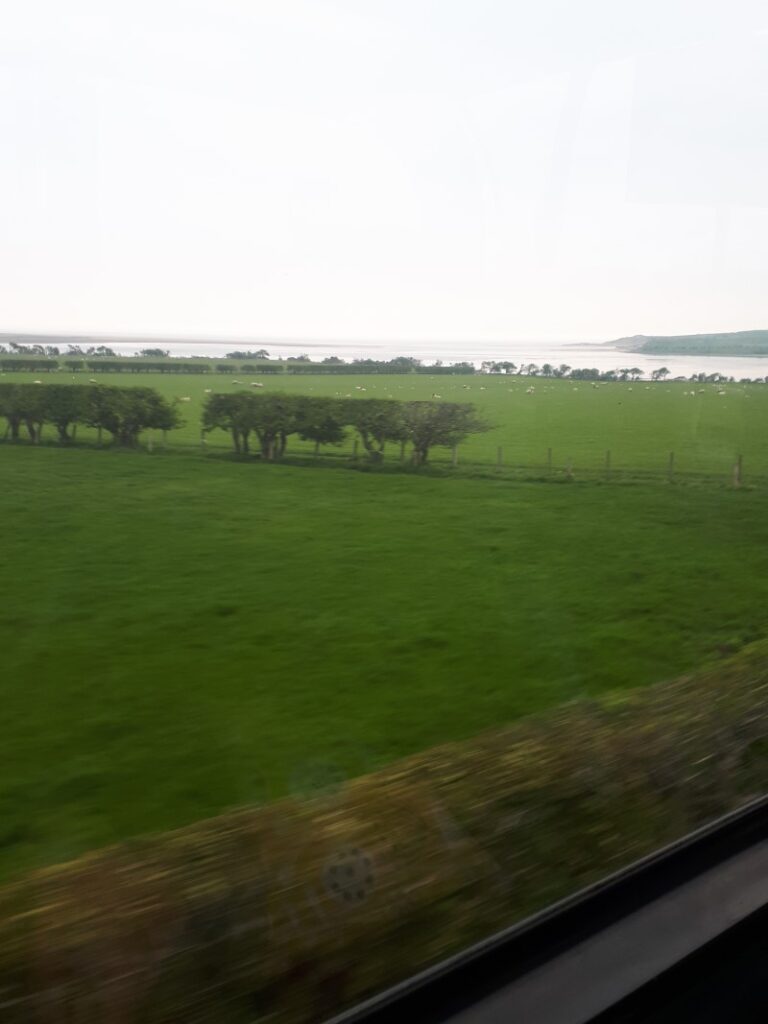
Now a caravan park, it is where Christopher Leyland developed the much derided Leylandii in 1888 (it first grew as a natural hybrid at his brother John’s estate in Powys). It didn’t spread much beyond the cultivar’s original six examples until, of all things, a tornado felled one of them 65-years later.
Commercial growers took note when cuttings from the stricken tree grew at an astonishing rate, and the new evergreen came to market with such fanfare that they soon accounted for 10% of total sales at garden centres across the UK. That was before people realised these innocent, infertile conifers could reach heights six times higher than a house and are unrivalled at blocking out the sun and TV reception.
Britain turned into the Leylandii of the Giants, with the plant being cited in tens of thousands of neighbourly disputes and even implicated in a murder case. The Leyland brothers couldn’t have known the cauldron of chaos they would unleash.
Sheep bask in the midday cloud on either side of Belford. Slack-tongued as they lay on their sides, they look as though they’ve breathed their last and are waiting for the farmer or a fox to scoop them up. That is until the bus drops a gear, the louder revs of the engine startling the lambs into emergency evasive action as they scatter and hide behind their nonplussed mums.
We’re into the realm of narrow winding lanes and high hedgerows, where individual houses are rare, never mind something as tangible as a hamlet. A plane slopes towards the boxy outline of Budle Bay, skirting inches from its benign waters before rising again as we advance towards Bamburgh. Its gigantic castle appears unannounced as we round a corner, causing the Aussie to scramble for his phone to livestream the experience.
‘Ladies and gentlemen,’ he drawls to his unseen audience. ‘This is Bamburgh Castle. Pretty awesome, eh?’
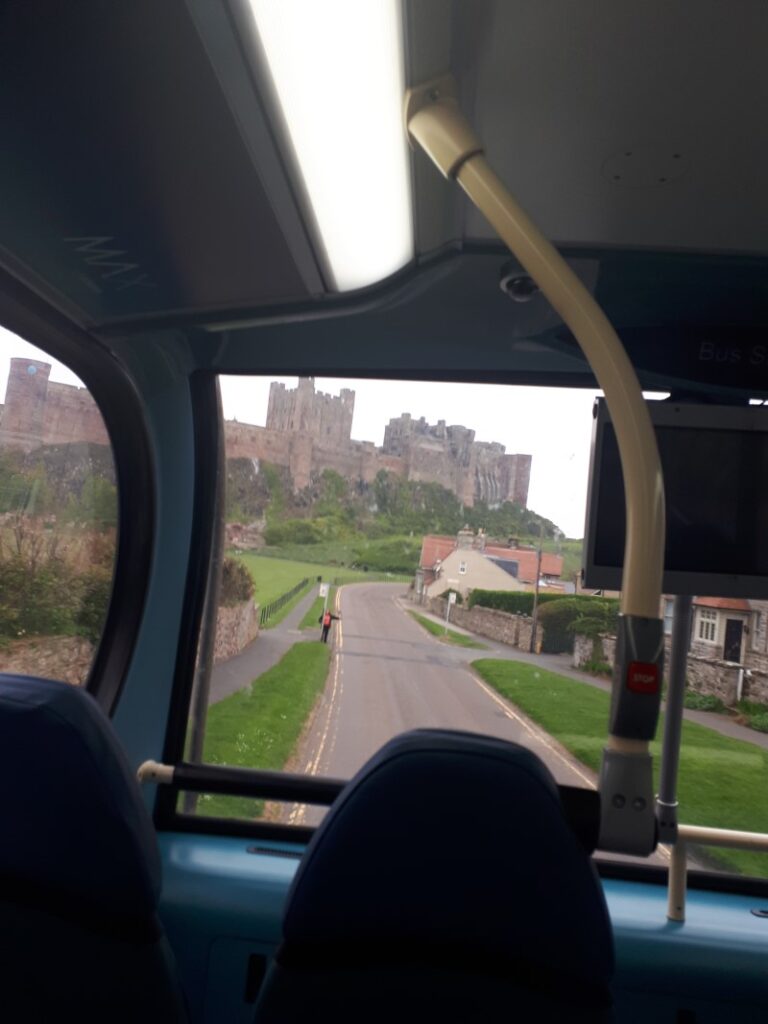
It is, and it looms over the quaint village below. There has been a fortification on this rocky outcrop for at least 1,500 years. Used as the capital of the Northumbrian kings in the early middle ages, the Vikings destroyed it, before a sturdy rebuild saw it change hands several times throughout the centuries.
The only armies congregating on Bamburgh Castle these days are flocks of walkers and school groups, dozens of whom tuck into their packed lunches around the edge of what has to be the world’s most picturesque cricket pitch, snuggled right at the foot of the fort. Just beyond, a cluster of wooden green cottages shelter from the worst of the weather behind a row of sand dunes; their undulating mounds knitted together by a tangle of grassy hair which stretches the entire four miles to Seahouses.
Erroneously credited with inventing kippers (in reality, cold-smoking fish has happened for thousands of years), Seahouses is the drop off point for the Farne Islands, lurking a few miles offshore. They may be where our antipodean chum is heading, as he departs to leave us as the sole occupants upstairs.
The rain predicted by the old lady earlier in Dunbar arrives as we hit Beadnell. It’s not coming down with any real gusto, but is enough to turn the windows into speckled prisms and lend the sea a Monet smudge. A red and yellow Northumberland county flag lies limp in the beer garden of the Craster Arms, waiting for a breath of wind to accompany the shower and bring it fluttering back to life.
Built into what was once a pele tower, the pub was once the home of the local lord, who would light a warning signal in case any Border Reivers were busy marauding nearby. The bus has its own troubles to negotiate, with a balletic manoeuvre seeing it avoid a cement mixer coming around a tight bend on our way out of the village.
Not only are we in a designated Area of Outstanding Natural Beauty, but Arriva markets the X18 as the ‘Coast & Castles’ route. There’s no chance that they’ll fall foul of the Trade Descriptions Act 1968 with that tag line, as we are rarely more than a couple of miles inland on this first leg, and Northumberland has far more castles than any other county in Britain. Over than 70 of them in all. As we pull into Embleton, the dramatic ruin of Dunstanburgh Castle reveals itself on the cliff edge.
Built in the early 1300s by Thomas, Earl of Lancaster, he was Edward II’s cousin and, after him, the wealthiest man in the land. Constructed in part as a vanity project – its footprint is even larger than the behemoth at Bamburgh – it was also an impenetrable bolt hole for an excellent reason. Lancaster was the chief instigator of a plot, in 1312, to execute the King’s favourite, Piers Gaveston. As you’d expect, Edward swore vengeance on those responsible for seeing off his companion. Lancaster was lucky, though. Events further north commanded the monarch’s attention.
The Battle of Bannockburn against Robert the Bruce in 1314 proved so calamitous that Edward ruled England in name only for the next four years, with Lancaster pulled the regnal strings and no doubt cackling diabolically the whole time. Usurped by the Earl of Winchester and his son, Lancaster’s decision to lead an ill-fated rebellion against the crown saw him sentenced to death for treason. Captured while fleeing to Dunstanburgh, he only visited his masterpiece once.
A tiny fraction of the original castle survives, serving as a moody edifice on the short drag to Craster, along which we see a series of wavy fields and a blackbird beating a worm to death against a rock. These ‘wavy fields’ appear to be in full tidal motion, with each ripple paced out evenly from the last. They’re called ridge and furrow and are the ghosts of ancient farmers. Any pasture showing these distinctive patterns haven’t seen a plough for hundreds of years, and sure enough, these are full of sheep and their busphobic lambs.
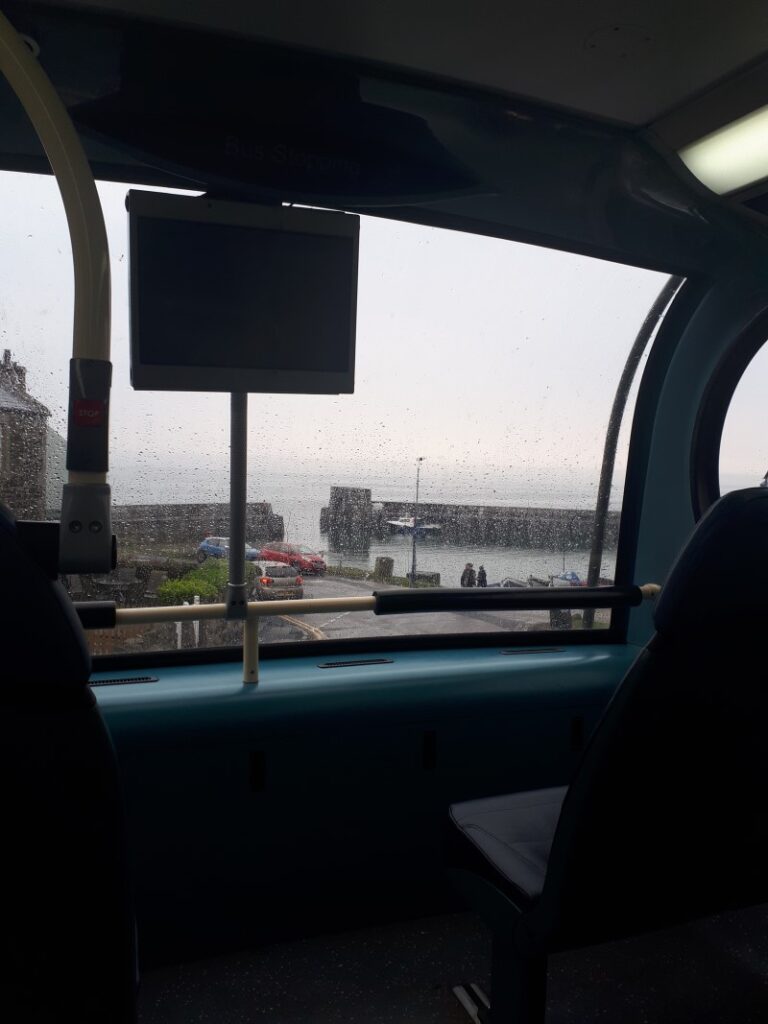
Not even the grim weather can snatch the romance away from Craster. Stone cottages with trim front gardens line the way downhill, where a pair of fishing boats shelter inside the miniscule keyhole harbour. It’s not the prettiest place in these parts, but despite the burgeoning presence of holiday cottages, it has otherwise rejected the tourist trap accoutrements and retains the essence of a working port. It feels alive.
The rain’s syncopated rhythm peters out as we twist our way towards Alnwick, passing a pheasant in every field along a road so bumpy that I almost lose consciousness. We careen through moguls, dart under bridges, and screech through a puddle so voluminous that it drenches a cow on the other side of a hedge.
‘Alnwick on the streets of London,’ we giggle in unison as we channel Morrissey on our way into town. Rather than the two-hour frequency from Berwick, the X18 runs hourly from here, so we break the journey in this unfamiliar outpost. A relaxed air and gentle eccentric streak permeates Alnwick. Its high street splits into two branches, both inhabited by independent shops selling parking permits for £1 as a side hustle. In need of a refuel, we head into Grannies Tea Room, just beneath yet another imposing castle (Alnwick’s doubled up as Hogwarts in the first two Harry Potter films).
Grannies vacuum packs twenty covers into a basement the size of the average bedroom. Lamps on the wall illuminate bare bricks, with pot figurines, brass ornaments and Toby Jugs balanced, stuck or nailed onto every available atom of space. Even though the dinner time rush is long gone, we squeeze onto the only spare table in the room, where a waitress in her early twenties approaches us.
‘Hiya,’ she says in an exaggerated whisper, as though she’s about to share some white-hot town gossip with us. Her mouth stretches to its limits with each fresh syllable as she simultaneously talks and beams a smile. ‘Here’s your menus, I’ll just be back in just a minute.’ It must be because every other patron is a good decade into their bus pass usage that she’s developed this way of hushed shouting, but it’s effective and she makes a mean giant teacake.
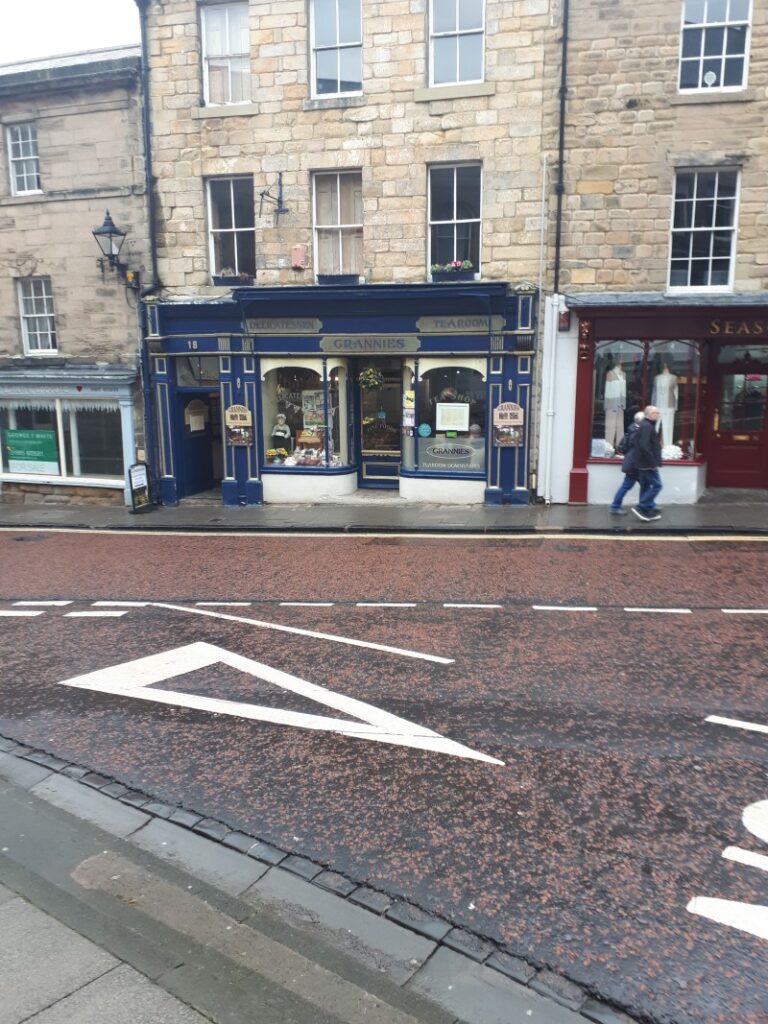
Back on the bus, the driver pops his head upstairs.
‘Excuse me. Is everybody satisfied that this is the X18?’
It may seem like an odd thing to ask seeing as people have just boarded it, but an X15 has pulled in next to us and will take the speedy route to Newcastle, straight down the A1. Overcome by a morass of dissatisfaction, four treacherous picaroons abandon ship to catch the speedier vessel on our left. Nothing good will come of them, I guarantee it, even if they do reach Newcastle half an hour to the good.
Instead, we take the rollercoaster A1068 back towards Alnmouth. It tests the double decker’s suspension and the discs in my back to their limits as we clank through a series of potholes, several of which are in danger of turning into full cave systems. As well as castles, Northumberland is the UK’s unofficial capital of potholed roads, with the county council filling in almost 15,000 more cavities than the next closest authority per year.
Rather than going into Alnmouth itself, the bus spins around on its outskirts and trundles along the western flank of the River Aln, where we gain enough elevation to peer along its estuary and across to the village. The only reason we can check anything out at all is thanks to the sacrifices made by our coat sleeves, which have mopped away the condensation from our side window. There’s a tiny porthole in the front window wiped clear by another passenger’s hand, but looking ahead is like a glimpse into a foggy future of cataracts.
It’s a real shame, as Warkworth is stunning. Weeping willows dip anchor into the River Coquet, houses are made from sandstone bricks the size of railway sleepers, and yes, there’s a whacking great castle which clears the rooftops for miles around. Of course there is, we’re in Northumberland. We follow the Coquet for a couple of miles as its throat widens and turns into a mouth beside Amble, a much more down-to-earth place on the coast. As with Alnmouth, we only flit around its edges, but any working-class seaside town with adverts for puffin cruises is right up my street.
We wave farewell to the shoreline as we turn inland and gallop alongside blankets of rapeseed, their tiny blossoms radiating a sunshine glow so strong that it’s easy to ignore the straggly, weed-like stems which prop them up. They’re early risers, keeping the soil at work throughout the winter, before being transformed into vegetable oil, animal feed or maybe even biofuel long before the surrounding wheat crops have grown their ears.
Dispersed between the farmland are former pit villages – Broomhill, Red Row and Widdrington among them – still recovering from their industry’s amputation, even if the closure of the mines had been on the cards for decades before the decisive blows rained down in the 1980s.
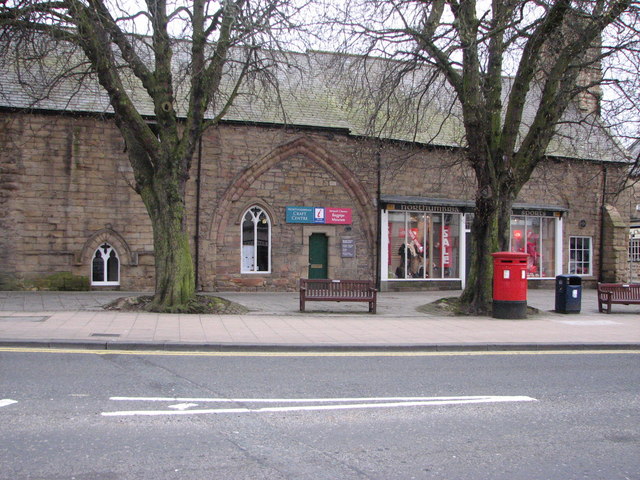
Morpeth is Northumberland’s county town, and so keen are the local councillors to keep it spotless for visitors and residents alike, that the fountain outside Morrisons is foaming as though it has had an entire bottle of Matey poured into its pipes. Speaking of pipes, Morpeth is an unlikely place to find a bagpipes museum, but that’s just what we pass. I hate bagpipes and their wheezing, asthmatic wails. The screeching top notes, the drone underpinning it.
I’ll admit that they’re an incredible invention. I mean, I’d never think in a million years to gut a sheep, attach pipes to the holes where its neck and legs once were, and squeeze out a tune. Although most Brits associate the pipes with Scotland, Arabs, Georgians, Basques and dozens of other cultures around the world independently saw an animal carcass and thought, ‘I know what we could do with that…’.
Why is there are bagpipe museum in Morpeth, though? The area has its own take on the instrument: the Northumbrian smallpipes. Rather than blowing into a dusty bladder like its brethren from across the border, bellows that rest under the player’s elbow instead force air in and sound out. This innovation led to late organologist, Anthony Baines, describing them as “perhaps the most civilised of the bagpipes”, as let’s face it, nobody wants to contract bagpiper’s lung.
A newly discovered disease prevalent in woodwind musicians, bagpiper’s lung is spread by colonies of fungal spores growing inside unkempt corners of their contraptions. So, not only do bagpipes sound dreadful, but they’re also a death trap.
The drizzle morphs into a squall, and although the windows have demisted, fatigue sets in all around. There’s a man huffing deeply on the other side of the aisle, a teenage girl has contorted her knees to rest her chin on them ahead of us, while Eleanor has resorted to listening to a podcast in lieu of using matchsticks to prop her eyes open. It can be tiring, this sitting on a bus business.
We join the A1 for the tepid final approach into Newcastle, where a sign promises a Little Chef a mile ahead, despite them shutting their grills off for good eighteen months earlier. Not even ignoring the advice of Heston Blumenthal could save their bacon after years of steady decline, and this is a final insult to peckish drivers from beyond the grave.
We enter the city via Gosforth, one of Newcastle’s more opulent postcodes, where competitive veg growing is second only to football as the local pastime of choice. Leeks are the produce of choice, and although the world record is held by Seaham’s Paul Rochester (a 10.7kg monster from 2018, and his third specimen to claim the crown), it’s a mark which ricochets between competitors from Northumberland, Durham, and Tyne & Wear allotments.
It’s a short run to Haymarket Bus Station, the site of the world’s first dog show in 1859, and time for a hard earned rest. We’re off to Whitby tomorrow!
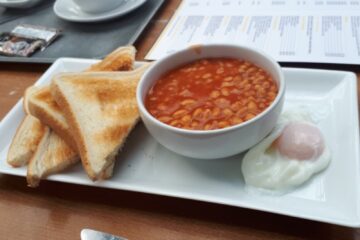

0 Comments